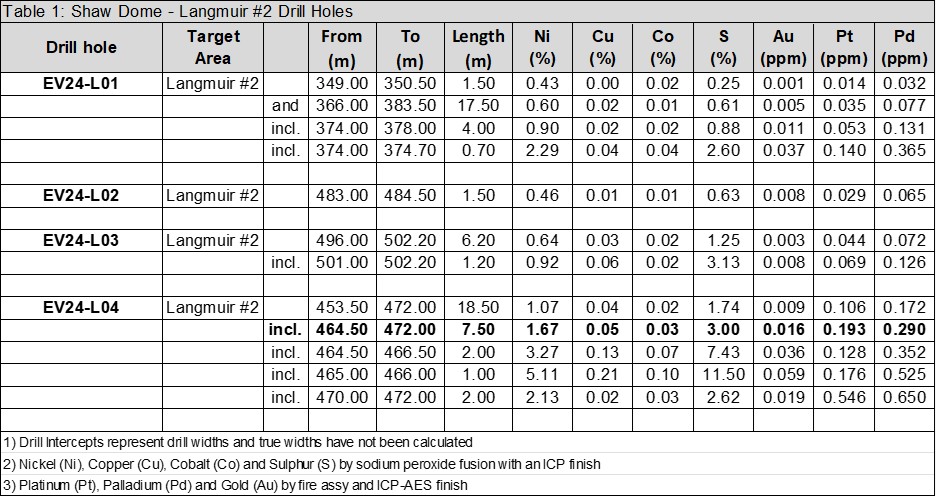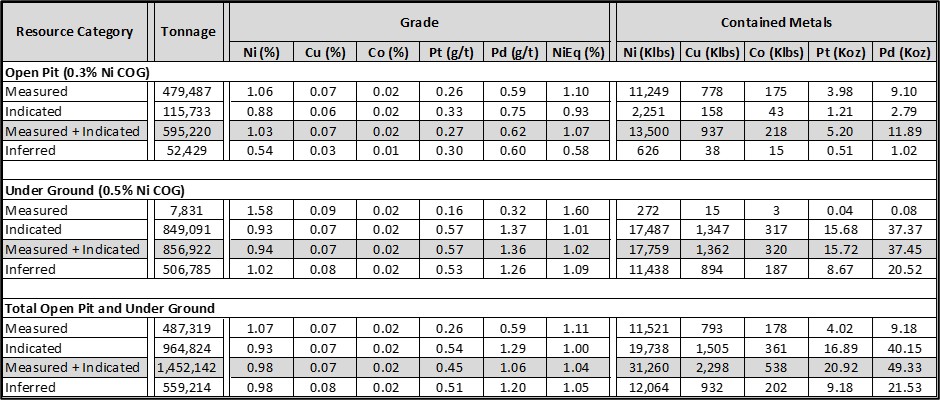2024 Exploration Results
The high-grade nickel intercepts from the 2024 drill program on the Langmuir #2 Nickel Zone are summarized in Table 1 below and with intercepts grading from 1.07% Ni to as high as 5.11% Ni in drill hole EV24-L04.

In addition, the assay analysis indicates that the nickel sulphides have a higher than expected nickel tenor ranging from ~12% to >40% Ni (nickel tenor is a calculated nickel content in 100% sulphide).
The 2024 diamond drill hole program was designed to confirm the down-plunge potential and demonstrate the exceptional potential of the mineralized trend that hosts additional high-grade nickel sulphides.
High-Grade Track- W4
The W4 Nickel Zone was discovered by drilling one of the anomalies in one of the clusters in early 2007 and a 43-101 Resource was reported in 2010 with approximately 15M lbs of Indicated Nickel in the historic estimate, with high-grade 1% Nickel. This was more than doubled with 2022-2023 drilling, and remains open at depth and along plunge. On June 12th, 2023 EVNi reported its Updated Mineral Resource Estimate for W4-

- The independent Qualified Person for the MRE, as defined by NI 43-101, is Mr. Simon Mortimer, (FAIG #4083) of Atticus Geoscience Consulting S.A.C., working with Caracle Creek International Consulting Inc. The effective date of the MRE is June 9, 2023.
- These Mineral Resources are not Mineral Reserves as they do not have demonstrated economic viability. The quantity and grade of reported Inferred Resources in this MRE are uncertain in nature and there has been insufficient exploration to define these Inferred Resources as Indicated. However, it is reasonably expected that the majority of Inferred Mineral Resources could be upgraded to Indicated Mineral Resources with continued exploration.
- The MRE was prepared following the CIM Estimation of Mineral Resources & Mineral Reserves Best Practice Guidelines (November 29, 2019).
- 3D geological modelling revealed that the mineralization exists as a single steeply dipping continuous unit that have been faulted, thickened, and displaced along five fault surfaces. The estimation has been carried out using “un-faulting” techniques, restoring the mineralization within each fault block to its pre-faulted position, estimating and then returning each block to its present location.
- Mineralized domains were based on a combination of lithological and structural contacts with internal boundaries based on the distribution of nickel mineralization, utilizing thresholds of 0.2% Ni to define the low-grade domain and 0.5% Ni to define the high-grade.
- Geological and block models for the MRE used core assays (1,977 samples), data and information from 70 surface diamond drill holes (23 from EVNI and 47 historical). The drill hole database was validated prior to resource estimation and QA/QC checks were made using industry-standard control charts for blanks, core duplicates and commercial certified reference material inserted into assay batches by EV Nickel Inc.
- Estimates have been rounded to three significant figures for Measured and Indicated categories, and two significant figures for the Inferred classification.
- The resource estimates have been constrained by a conceptual open pit using the following optimization parameters, as reviewed and agreed to by the QP. Metal prices used were (US$) $8.00/lb nickel, $3.25/lb copper, $13.00/lb cobalt, $900/oz for platinum and $1,200/oz for palladium. An overall pit slope of 50 degrees was used. Mining and processing costs (US$) were based on benchmarking from similar deposit types in the area, utilizing a mining cost of $3.80/t, a processing cost of $45.00/t, a G&A cost of $5.00/t, and a selling cost of $8/lb. All resources below the conceptual pit are considered extractable via underground mining scenarios. A cut-off grade of 0.30% Ni was applied to the resource block model for the portion that could be extracted via open pit mining method and a cut off grade of 0.5% Ni applied to the portion of the block model below the optimized conceptual pit.
- The MRE comprises nickel, cobalt, copper, platinum and palladium and considers a calculation of nickel equivalent (“NiEq”), calculated using the metal prices (US$) $8.00/lb nickel, $3.25/lb copper, $13.00/lb cobalt, $900/oz for platinum and $1,200/oz for palladium, and considering recoveries of 85% for nickel, 80% for cobalt, 70% for copper, 50% for platinum, and 50% for palladium.
- The block model was prepared using Micromine 2020. A 3 m x 3 m x 3 m block model was created, with sub blocks to 1 m x 1 m x 1 m. Drill composites of 1.5 m intervals were generated within the estimation domains, and subsequent grade estimation was carried out for Ni, Cu, Co, Pt and Pd using Ordinary Kriging interpolation method.
- Grade estimation was validated by comparison of input and output statistics (Nearest Neighbour and Inverse Interpolation methods), swath plot analysis, and by visual inspection of the assay data, block model, and grade shells in cross-sections.
- Density estimation was carried out for the mineralized domains using the Ordinary Kriging interpolation method, on the basis of 228 specific gravity measurements collected by EVNi during the core logging process and 90 from historical reporting, using the same block model parameters of the grade estimation. As a reference, the average estimated density value within the mineralised domain is 2.82 g/cm3 (t/m3). A Technical Report in support of the MRE will be filed on SEDAR (www.sedar.com) within 45 days of the date of this news release. The MRE is effective as of June 9, 2023. On a Nickel Equivalent basis (“NiEq”), this Measured & Indicated Resources of 31.3M pounds at 0.98% Ni, works out to 33.2M NiEq pounds (2.2x the 2010 historical estimate on a NiEq basis) and the Inferred Resources of 12.1M pounds at 0.98% Ni works out to 12.9M pounds (3.8x the 2010 historical estimate on a NiEq basis).
A Technical Report in support of the MRE has been filed on SEDAR (www.sedar.com) with an effective as of June 9, 2023.
On a Nickel Equivalent basis (“NiEq”), this Measured & Indicated Resources of 31.3M pounds at 0.98% Ni, works out to 33.2M NiEq pounds (2.2x the 2010 historical estimate on a NiEq basis) and the Inferred Resources of 12.1M pounds at 0.98% Ni works out to 12.9M pounds (3.8x the 2010 historical estimate on a NiEq basis).
